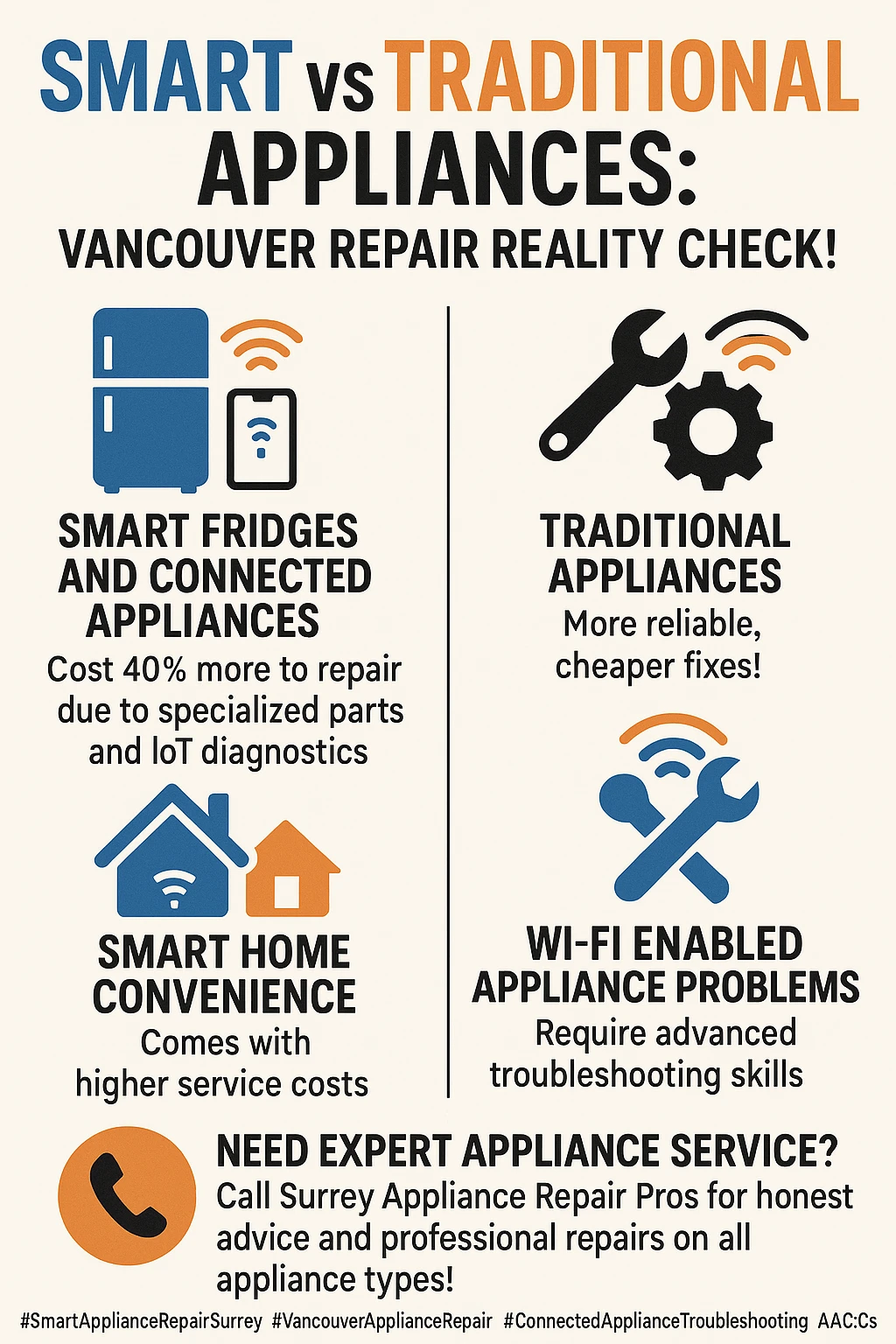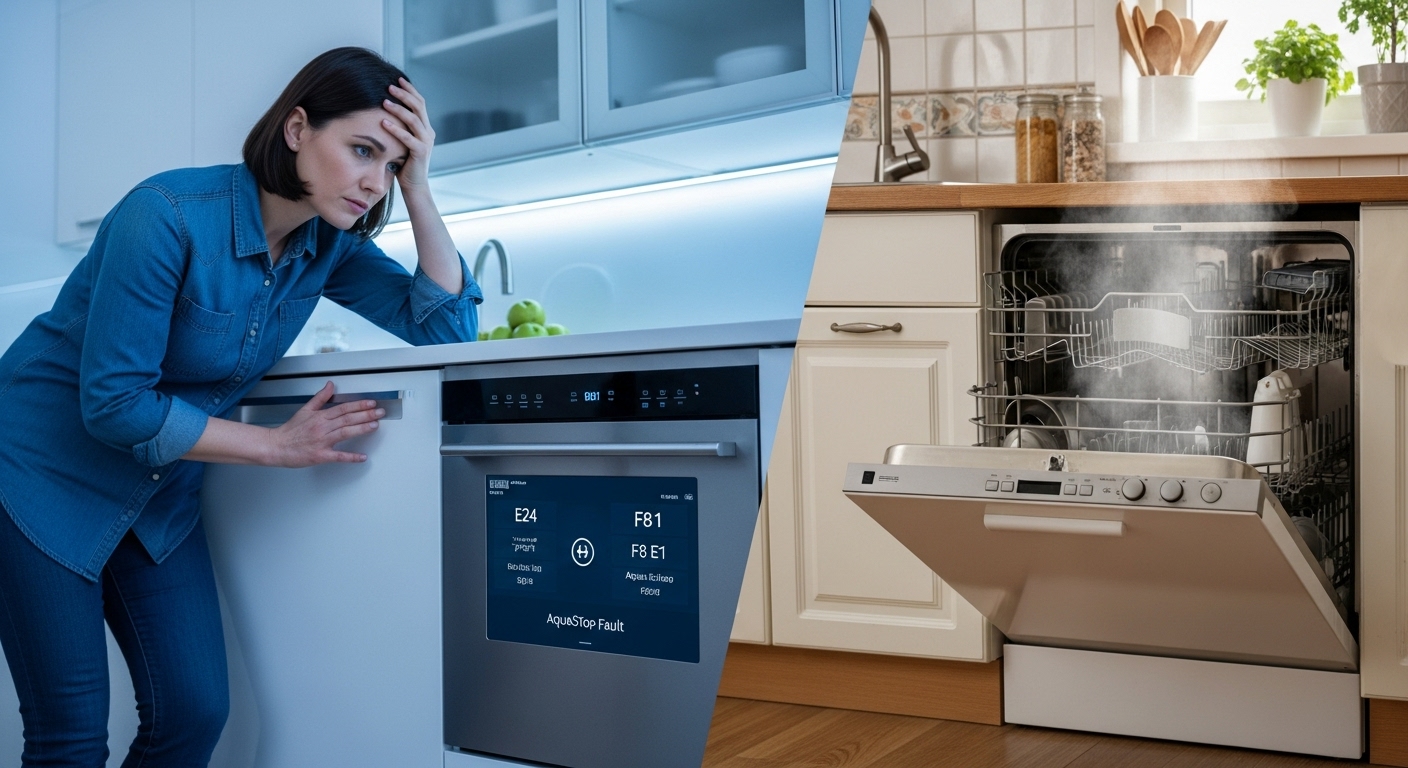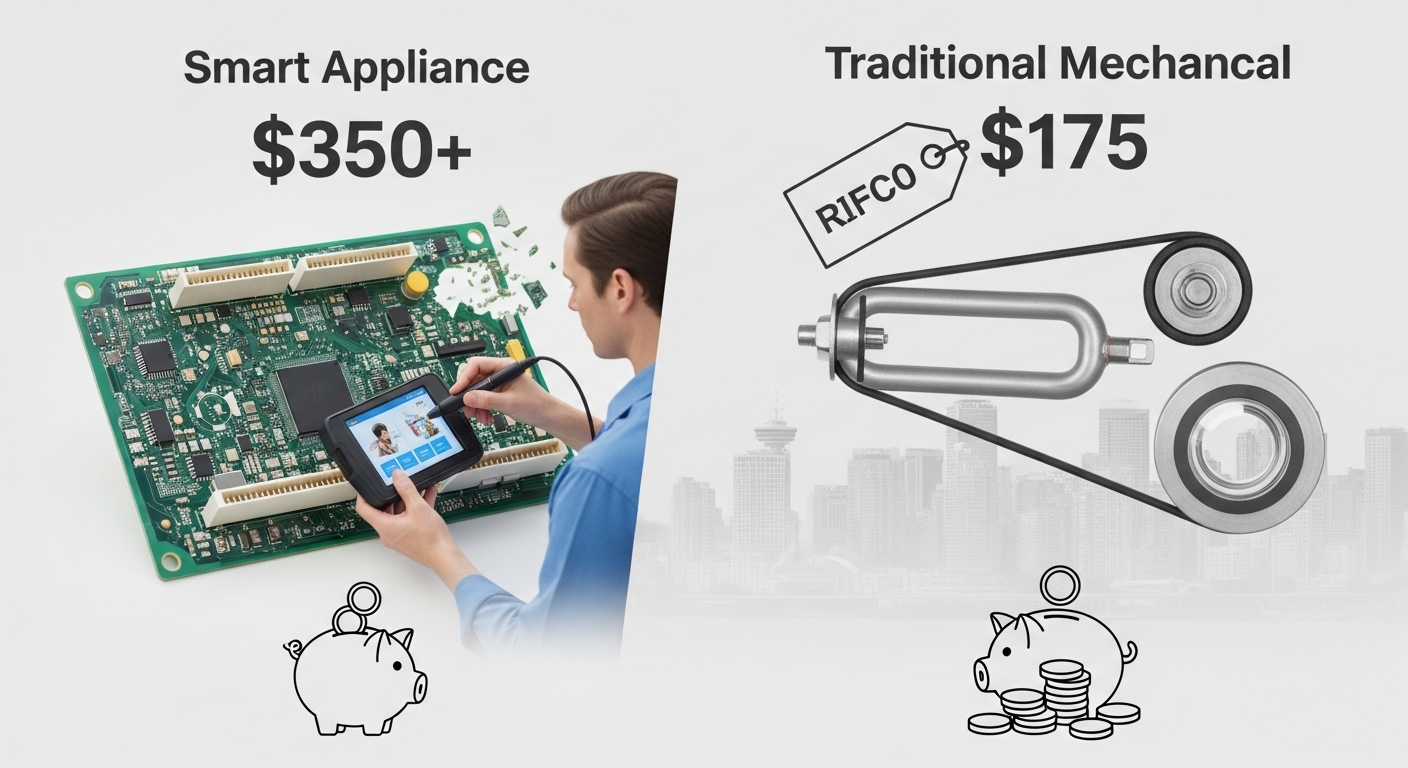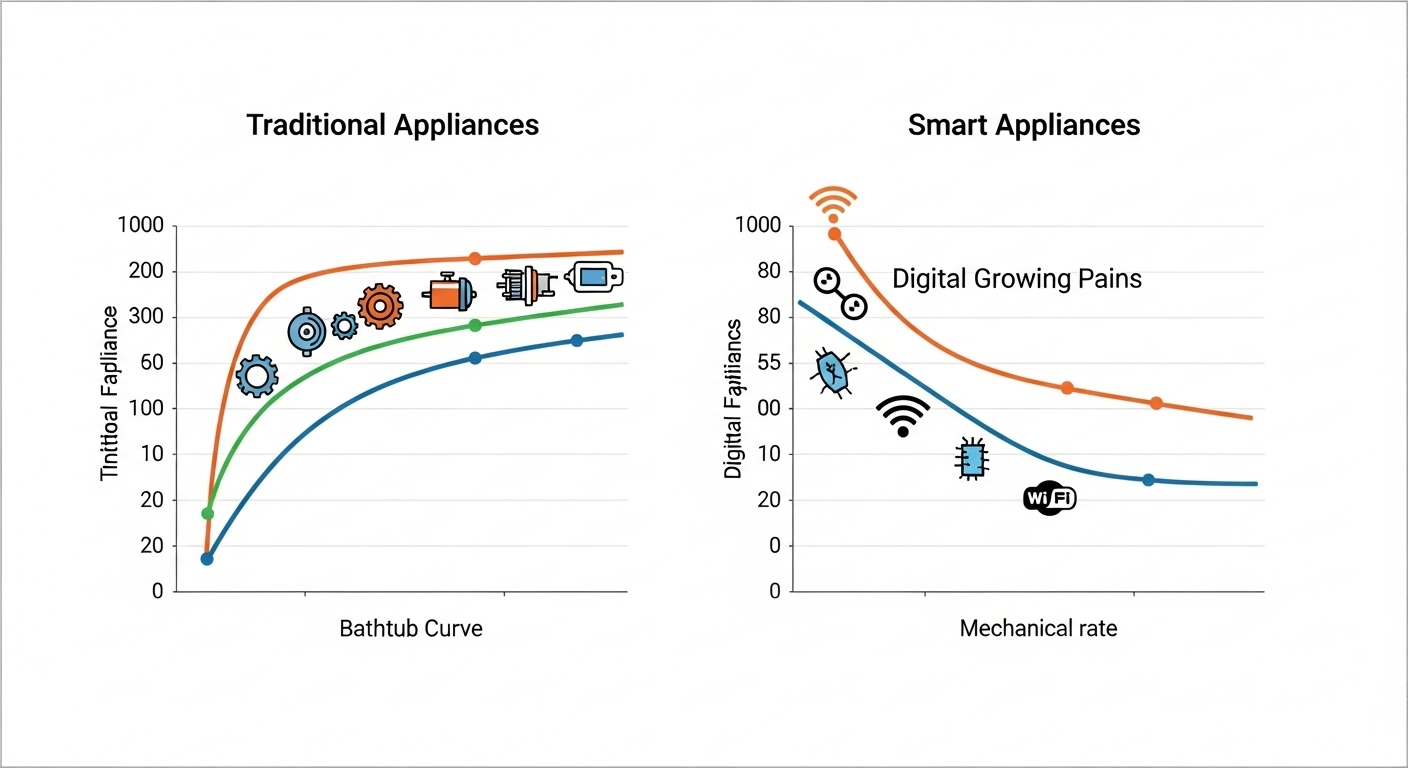**Torn between upgrading to smart appliances or sticking with your trusty traditional ones? We’re diving deep into the real costs of ownership, repair frequency, and what Vancouver homeowners actually experience when their high-tech gadgets go haywire versus when old-school appliances call it quits.**
Picture this: you’re standing in your kitchen at 7 AM, coffee mug in hand, and your smart dishwasher starts flashing error codes like it’s trying to communicate with aliens from another galaxy. Meanwhile, your neighbor’s 15-year-old traditional dishwasher is humming along like a trusty old friend who never lets you down. Sound familiar? This scenario plays out in homes across Vancouver every single day, and it’s got homeowners scratching their heads about whether all that fancy tech is really worth the potential headaches.
As someone who’s spent way too much time researching appliance failures and repair costs (yes, I’m that person who gets excited about warranty comparisons), I’ve discovered that the smart versus traditional appliance debate isn’t just about convenience – it’s about your wallet, your sanity, and how much you enjoy troubleshooting technology at ungodly hours. The truth is, both smart and traditional appliances have their breaking points, but they fail in completely different ways that can impact your bank account and your daily routine.
Let me take you on a journey through the world of appliance reliability, repair costs, and the very real experiences of Vancouver homeowners who’ve dealt with both high-tech marvels and old-school workhorses. We’ll explore everything from the mysterious world of software updates gone wrong to the simple beauty of mechanical parts that just wear out over time.
Key Outtakes:
- Smart appliances typically experience software-related failures within the first 2-3 years, while traditional appliances usually face mechanical wear after 7-10 years of use
- Repair costs for smart appliances average 20-30% higher due to specialized parts and diagnostic requirements
- Traditional appliances have more predictable failure patterns and often allow for DIY troubleshooting, reducing service call expenses
- Smart appliance repairs frequently require specialized technicians familiar with both mechanical and digital systems
- Vancouver’s tech-savvy market has created a growing demand for smart appliance repair services, but availability varies by brand and model

Understanding the Core Differences in Appliance Reliability

When we talk about appliance reliability, we’re essentially comparing two completely different approaches to getting the job done in your home. Traditional appliances are like that reliable friend who shows up on time, does exactly what they promised, and doesn’t complicate things with unnecessary drama. They operate on straightforward mechanical principles – switches flip, motors turn, heating elements heat up, and water flows through pipes. When something goes wrong, it’s usually pretty obvious: a belt breaks, a motor burns out, or a seal starts leaking.
Smart appliances, on the other hand, are like that brilliant but high-maintenance friend who can do amazing things but also needs constant attention and sometimes has mysterious mood swings. They combine traditional mechanical components with sophisticated electronic systems, sensors, Wi-Fi connectivity, and software that can be updated remotely. This means they have twice as many potential failure points – both the mechanical parts that can wear out and the digital components that can glitch, crash, or become incompatible with updates.
The fundamental difference lies in complexity and predictability. Traditional appliances follow well-established patterns of wear and tear that appliance repair technicians have been dealing with for decades. A washing machine’s transmission might start making noise before it fails completely, giving you warning signs and time to plan for repairs. Smart appliances can fail suddenly due to software bugs, connectivity issues, or sensor malfunctions that provide little to no warning.
The Real Cost Breakdown: Smart vs Traditional Appliance Repairs in Vancouver
Let’s talk money – because at the end of the day, that’s what keeps most of us awake at night when our appliances start acting up. The cost difference between repairing smart and traditional appliances goes far beyond just the price of replacement parts, and understanding these differences can help you make more informed decisions about your home’s appliance ecosystem.

Traditional appliance repairs are generally straightforward affairs. When a heating element burns out in your dryer, the technician orders a $40 part, spends 30 minutes installing it, and charges you for the part plus labor. The diagnostic process is usually quick because experienced technicians can identify common problems based on symptoms and visual inspection. Most mechanical failures are obvious – you can hear grinding noises, see leaking water, or notice that something isn’t heating up properly.
Smart appliance repairs, however, operate in a completely different cost structure. According to industry data, standard appliance repair costs around $175, while smart appliance repairs often cost upwards of $350. This significant difference stems from the extended diagnostic time needed to troubleshoot both mechanical and digital systems. Technicians need to run software diagnostics, check connectivity issues, calibrate sensors, and test various electronic components. This extended diagnostic time translates directly into higher labor costs, even before any parts are replaced.
The parts themselves also tend to be more expensive for smart appliances. While a traditional dishwasher might need a $25 door seal, a smart dishwasher might need a $150 control board replacement. Electronic components generally cost more than mechanical ones, and they often need to be ordered directly from the manufacturer rather than sourced from generic parts suppliers. In Vancouver specifically, diagnostic service calls range from $100-$230, with repair costs varying significantly based on the complexity of both the appliance and the underlying problem.
Vancouver Climate Impact on Repair Frequency
Here’s something that might surprise you: Vancouver’s coastal climate with salt air and humidity creates unique challenges for smart appliances’ electronic components. The salty ocean breeze that makes our summers so pleasant can actually accelerate corrosion on circuit boards and sensors, potentially leading to more frequent connectivity issues and sensor malfunctions. Traditional mechanical systems, being less sensitive to environmental factors, tend to be more resilient to these coastal conditions.
I’ve spoken with local repair technicians who’ve noticed patterns in smart appliance failures during Vancouver’s particularly humid winter months, when condensation can affect sensor accuracy and connectivity reliability. This environmental factor adds another layer of complexity to the cost equation that homeowners in inland cities don’t typically face.
Specialized Technician Requirements
Here’s something that many homeowners don’t realize until they’re faced with a malfunctioning smart appliance: not all repair technicians are created equal. Traditional appliance repair requires mechanical knowledge and experience with common failure patterns. Smart appliance repair requires all of that plus expertise in electronics, software troubleshooting, and often specific brand training for proprietary systems.
This specialization shortage drives up costs in several ways. First, technicians with smart appliance expertise often command higher hourly rates because their skill set is more specialized and in higher demand. Second, if your local repair service doesn’t have smart appliance capabilities, you might need to wait longer for service or pay premium rates for a specialist to travel to your location. Third, some smart appliance issues require remote diagnostics or software updates that can only be performed by manufacturer-certified technicians.
Breakdown Frequency and Common Failure Points
Now here’s where things get really interesting, and I’m going to share some insights that might surprise you based on real-world data from Vancouver appliance repair services. The frequency of breakdowns between smart and traditional appliances tells a fascinating story about how different technologies age and fail over time.

Traditional appliances typically follow what repair technicians call the “bathtub curve” – they might have some early failures if there are manufacturing defects, then they settle into a reliable middle period that can last 10-15 years, followed by increasing failure rates as components wear out. The most common issues are mechanical: worn bearings in washing machines, failed heating elements in dryers, clogged drain pumps in dishwashers, and compressor problems in refrigerators. These problems are predictable, and experienced homeowners often recognize the warning signs.
Smart appliances, however, have a different failure pattern entirely. They experience what I like to call “digital growing pains” in their first few years, where software bugs, connectivity issues, and sensor calibration problems can cause frequent service calls. A smart refrigerator might stop connecting to Wi-Fi after a router update, or a smart oven might display temperature readings that don’t match reality due to a sensor glitch. These aren’t mechanical failures – they’re

